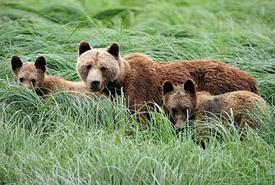Natural corridors 101

Glendale grizzlies, British Columbia (Photo by Klaus Gretzmacher)
Part of a species' ability to adapt to environmental change is the opportunity to move to places that are more suitable. That's where natural corridors come in.
What is a natural corridor?
Natural corridors are bands of land that link two or more patches of habitat in highly fragmented areas.
Why are natural corridors important?
These bands of land allow animals to move to new areas if they are faced with threats such as overpopulation, fire or food scarcity.
But with the conversion of natural habitat for agricultural, commercial and urban uses, the places that are suitable for species to move are becoming increasingly rare. If left on their own, natural habitats can become isolated islands and populations can disappear.
Who needs natural corridors?
Natural corridors are critical to the survival of wide-ranging mammals that need large expanses of habitat to survive.
But they are also crucial for all species, even plants, to maintain genetic diversity.
If a tree species can’t seed into the next woodlot because of a highway or other barrier, and if the conditions change so much that it can no longer survive where it currently exists, that population is more likely to be lost.
How can these corridors be conserved?
The more natural the landscape overall, the better the connectivity overall.
Conversely, the more fragmented a landscape is, the more groups like NCC need to start planning for connectivity and linkages by conserving natural corridors such as the Frontenac Arch in Ontario.
What is NCC doing?
NCC’s landscape-scale planning allows scientists to identify key natural corridors. The goal is to create a network of protected places that includes both large protected areas and natural corridors.
“Ideally, all of our protected areas should be connected across the landscape,” notes Michael Bradstreet, former senior vice-president, new conservation strategies, for the Nature Conservancy of Canada (NCC).
“But in addition to connecting our properties, we need to maintain real connections with local communities and landowners,” adds Bradstreet.
By partnering with these groups and promoting a strong respect for and appreciation of the land, NCC can help influence best practices in the broad landscape that complement networks of protected areas.




